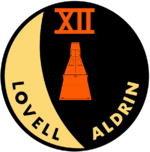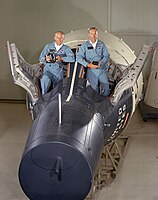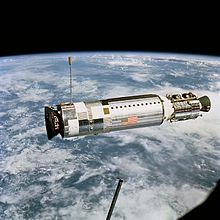Gemini 12
| Mission emblem | |||
|---|---|---|---|

|
|||
| Mission dates | |||
| Mission: | Gemini 12 | ||
| COSPAR-ID : | 1966-104A | ||
| Spacecraft: | Gemini 12 | ||
| Launcher: | Titan II Gemini 62-12567 | ||
| Crew: | 2 | ||
| Begin: | November 11, 1966, 20:46:33 UTC JD : 2439441.3656597 |
||
| Starting place: | LC-19 , Cape Canaveral | ||
| Number of EVA : | 3 | ||
| Landing: | November 15, 1966, 19:21:04 UTC JD : 2439445.3062963 |
||
| Landing place: |
Atlantic 24 ° 35 ′ N , 69 ° 57 ′ W |
||
| Flight duration: | 3d 22h 34min 31s | ||
| Earth orbits: | 59 | ||
| Recovery ship: | USS Wasp | ||
| Orbit inclination : | 28.87 ° | ||
| Apogee : | 270.6 km | ||
| Perigee : | 160.8 km | ||
| Team photo | |||
 from left Edwin Aldrin and James Lovell |
|||
| ◄ Before / After ► | |||
|
|||
Gemini 12 (GT-12) was the last space flight under the US Gemini program .
crew
Shortly after Gemini 9 landed on June 17, 1966, NASA announced that the replacement crew on that flight would take over the next available mission in the Gemini project, the Gemini 12 final flight.
Jim Lovell , who held the long-term record of a space flight with Gemini 7, became the commander . His copilot was Edwin Aldrin , for whom it was to be the first space flight.
The replacement team consisted of Gordon Cooper and Eugene Cernan , who were already in space with Gemini 5 and Gemini 9 respectively.
Liaison spokesman ( Capcom ) during the launch was Stuart Roosa . Pete Conrad and William Anders later took over from Houston .
preparation
As should also be at Gemini 12 in the previous Geminiflügen coupling to a target satellite and the alighting be carried out from the spacecraft. Simple work should then be carried out in space. Unlike previous Gemini missions, Aldrin trained underwater for his EVA. As it turned out later, this type of training was the decisive improvement for the EVAs.
The original plan was to test the AMU rocket backpack , which was not possible with Gemini 9 because of the difficulties encountered with Cernan's EVA. For this reason (as well as due to general concerns of the NASA management about Aldrin's suitability), it has meanwhile been considered to replace Aldrin with Cernan, which is already familiar with the AMU. However, this did not happen because the AMU test was ultimately rejected as being too ambitious.
The Gemini spacecraft was delivered to Cape Kennedy on September 6th, and the Titan rocket was installed on the launch pad on September 19th. The spaceship was assembled on September 23.
Flight history
The target satellite GATV-12 (Gemini Agena Target Vehicle) was launched one and a half hours before Gemini 12 with an Atlas Agena rocket . Lovell and Aldrin paired the two spacecraft during the third orbit, navigating with the sextant and flying by sight because the on- board radar was not working properly.
As with Gemini 11 , there was enough fuel left to repeat the pairing several times. Since problems arose during the launch of the Agena rocket, it was decided not to ignite the GATV-12 engine in order to bring the combination into a higher orbit.
Instead, the observation of a solar eclipse over South America was briefly included in the flight plan.
Soon afterwards, Aldrin was preparing for his first spacewalk (EVA English extra vehicular activity, short) before. Unlike most previous Gemini flights, he was supposed to do a stand-up EVA first , where he stood in the open hatch. Aldrin deliberately worked slowly and observed all reactions in order to compare them with the later space exit on the safety line. This EVA lasted two hours and 20 minutes.
The next day, Aldrin left the spacecraft completely and worked on both the GATV-12 and the Gemini spacecraft. Because of his training as a diver and because of the additional foot and hand brackets that have now been attached to the Gemini capsule, he was significantly more successful in spacecraft than his colleagues on previous missions. He even got around to wiping the outside of the window, as dirty windows were a nuisance on all Gemini flights.
Another stand-up EVA of one hour was carried out the following day.
After 59 orbits the Earth, Gemini 12 fired the braking missiles and initiated re-entry . During the phase of the highest deceleration forces, a utensil bag, which was attached to the side wall of the landing capsule with Velcro, came loose and landed on Lovell's lap. Lovell didn't dare to grab the bag as it was close to the ejector seat trigger .
Gemini 12 splashed down 4.8 kilometers from the planned landing point. The astronauts were greeted by a helicopter aboard the USS Wasp brought.
Significance for the Gemini project
Despite minor glitches, Gemini 12 was a successful completion of the Gemini program. Again it was possible to couple two spacecraft in orbit several times. The three EVAs from Aldrin brought valuable insights for work in space.
After this last Gemini flight was completed, NASA was able to concentrate all the forces of manned space travel on the Apollo program , the goal of which was the moon landing. For several months, Gus Grissom , Edward White and Roger Chaffee had been preparing to fly the first manned Apollo spacecraft. Three unmanned launches had already taken place, the manned premiere was to take place in the spring of 1967, but the Apollo 1 catastrophe on January 27, 1967 prevented this.
See also
Web links
- Gemini 12 in the NSSDCA Master Catalog (English)
- NASA: Mission Overview (English)
- Radio communication protocols (PDF; 35 MB / 11 MiB)


